Vizio Thin+Light CT15: Something New and Edgy
by Vivek Gowri on February 14, 2013 9:00 AM EST- Posted in
- Laptops
- Intel
- IPS
- Ivy Bridge
- Vizio
- Ultraportable
- Ultrabook
I’m going to run through our benchmark suite pretty quickly, because we’re pretty familiar with the ultra low voltage Ivy Bridge parts by now. The i7-3517U is the most common ULV i7 SKU, and the second most common Ultrabook part after the i5-3317U. Clock speed of 1.9GHz, max turbo of 3.0GHz, and HD4000 are all part of the package.
| Laptop Configuration Overview | ||||
| Laptop | CPU | Graphics | Storage | Battery |
| Acer Aspire S3-951-6432 | Intel i7-2637M | HD3000 | 256GB SSD | 38Wh |
| Acer Aspire S5-391-9860 | Intel i7-3517U | HD4000 | 2x128GB SSD | 35Wh |
| Acer Aspire S7-391-9886 | Intel i7-3517U | HD4000 | 2x128GB SSD | 35Wh |
| Apple MacBook Air 13 (Mid-2012) | Intel i5-3427U | HD4000 | 256GB SSD | 50Wh |
| ASUS Zenbook Prime UX31A-DB71 | Intel i7-3517U | HD4000 | 256GB SSD | 50Wh |
| Dell XPS 13 | Intel i7-2637M | HD3000 | 256GB SSD | 47Wh |
| HP Envy 14 Spectre | Intel i7-3667U | HD4000 | 2x128GB SSDs | 56Wh |
| HP Folio 13 | Intel i5-2467M | HD3000 | 128GB SSD | 60Wh |
| Intel IVB Ultrabook Prototype | Intel i5-3427U | HD4000 | 240GB SSD | 47Wh |
| Toshiba Satellite U845-S406 | Intel i5-3317U | HD4000 | 500+32GB Hybrid | 54Wh |
| Toshiba Satellite U845W-S410 | Intel i5-3317U | HD4000 | 500+32GB Hybrid | 54Wh |
| Vizio Thin+Light CT15-A5 | Intel i7-3517U | HD4000 | 256GB SSD | 52Wh |
Performance is very much in line with the Acer Aspire S7 that Jarred reviewed, with the main difference between the two systems being Vizio’s single Toshiba 256GB SSD versus Acer’s two 128GB Lite-On drives in RAID 0 and the extra RAM in the Acer. Again, being limited to 4GB of memory in the Vizio is a bit annoying, but in the grand scheme probably not a huge deal for most. I’ve recently been dealing with a number of systems with only 4GB RAM—MacBook Air, Surface Pro, other Ivy Bridge tablets, my trusty ASUS Zenbook Prime—and they’ve all held up well in casual use. I think anything less than 8GB RAM is a bit rough for any serious system, but 4GB is a livable limit for a machine in this class.
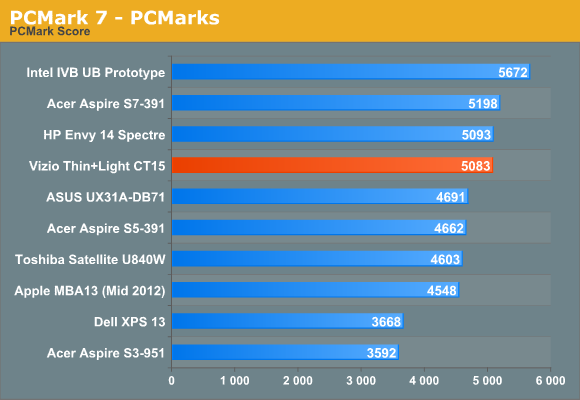
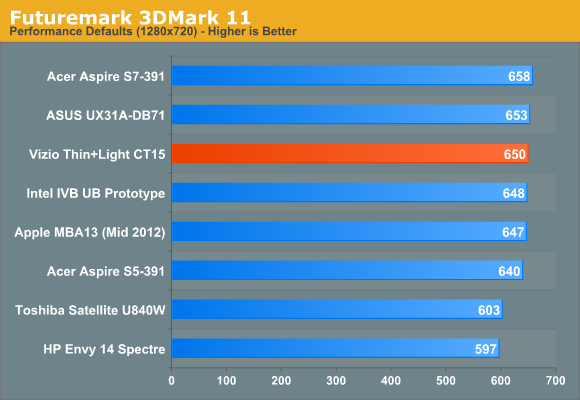
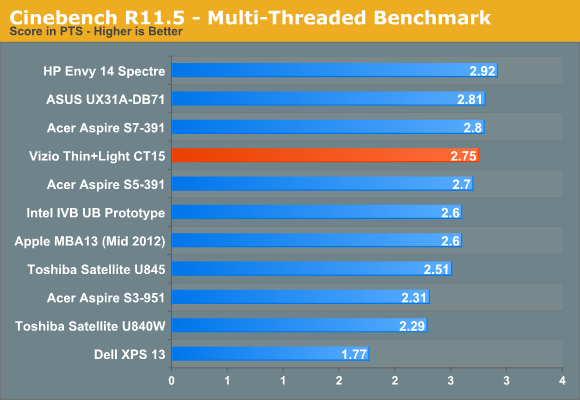
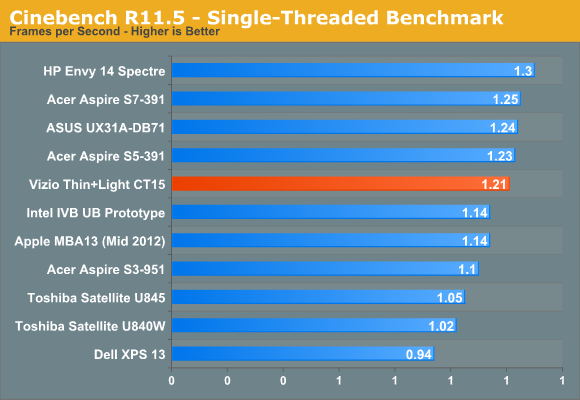
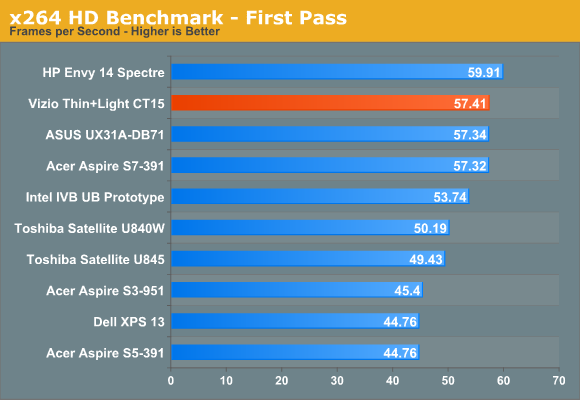
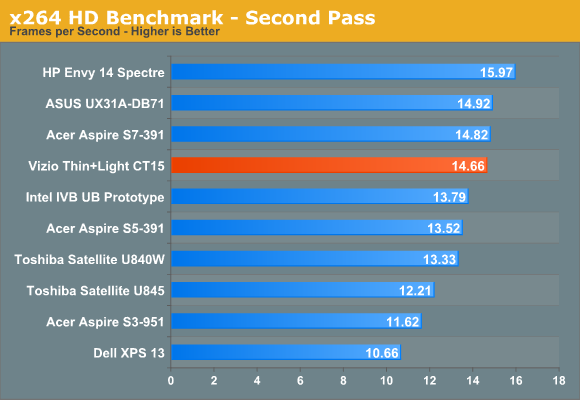
The CT15 has a 52Wh 6-cell li-poly battery that theoretically gives it decent battery life. Unfortunately, it doesn’t really hold up to that in real life, though you can point to a few reasons for that. We saw around five hours in our ideal case test and a hair over four in our internet test that tends to be a better barometer of what you can expect in typical daily use.
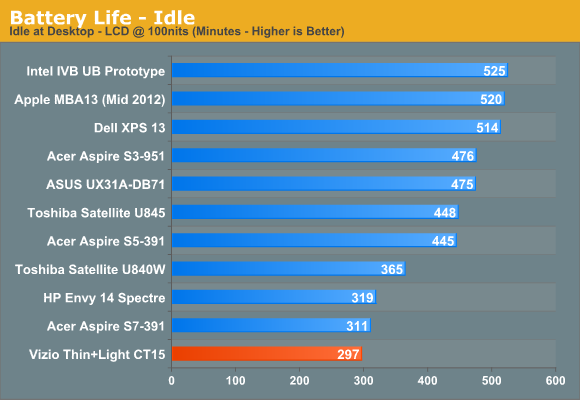
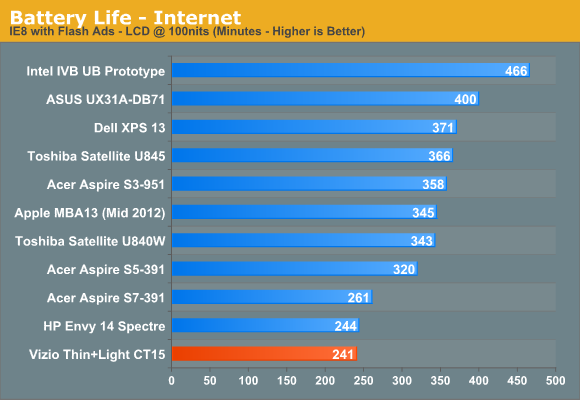

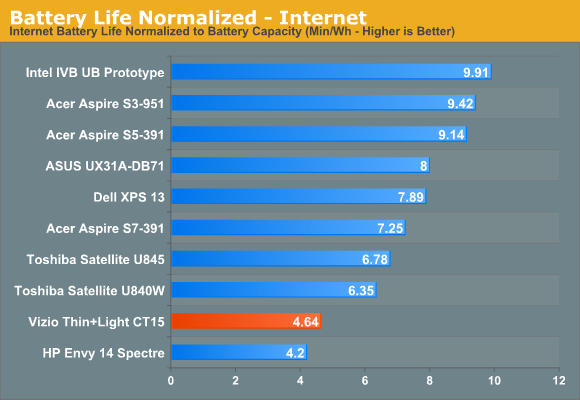
Those numbers seem low, as does the three hours and change in our HD video benchmark, but I think the main culprit is the 1080p 15.6” display. The increase in display size and resolution easily accounts for the increase in overall power draw compared to the 13” Ultrabooks we’ve seen thus far. Other than the Vizio and the HP Envy Spectre, every other notebook in the graphs is a 13” Ultrabook, which is why both the Vizio and the HP come off looking quite poor. Apple went with a 95Wh battery for the Retina MacBook Pro to end up at the 7 hour mark, versus 77.5Wh for the regular 15” MBP and 63.5Wh for the 13” (all three of which end up in the 7-8 hour range for battery life) so you can see how the 52Wh battery results in a relatively low runtime even with a ULV processor.
This issue gets fixed in the next-gen touchscreen Thin+Light, which has “nearly double” the capacity. I doubt it gets to the 100Wh mark, but even if it ends up near the 15” MacBook Pro in terms of capacity, it should be good enough for something along the lines of 6-7 hours of real world usage.










55 Comments
View All Comments
MarcusMo - Friday, February 15, 2013 - link
Regarding the ports, these two statements are from your preview of the new Vizios at CES as well as the current review:"The selection of ports onboard is pretty disappointing as well"
"I think I’d still like to see some improvements in terms of ports on offer (2xUSB and no SD slot just isn’t enough)"
If you are going to tell someone to have reasonable expectations and "not to cry about ports", it is best not to have done it yourself several times first.
chrnochime - Thursday, February 14, 2013 - link
I don't see the link for the next CT15 announcement that's referred to in this article. Could someone post the link?Ninhalem - Thursday, February 14, 2013 - link
http://www.vizio.com/ces#!/thin-lightvectorm12 - Thursday, February 14, 2013 - link
I've been looking for a decent new laptop for a couple of months now. Thus far the closest I've come are some of the Sony Vaio computers. This version is a nogo for me as I imagine I couldn't live with the flex in the chassi. If some retailer in Sweden starts selling the revamp I'm gonna buy one. Too bad I can't find a single one in Sweden currently carrying Vizio. Here's hoping...kyuu - Thursday, February 14, 2013 - link
The upcoming revision sounds like a real winner if it really fixes the flex/keyboard issues and includes a bigger battery. Also being able to put an AMD A10 in there for some basic gaming on-the-go will be great. I'm just torn between getting this or their upcoming Tablet PC. Hopefully you guys will do a review of that in the near future.I don't really get the complaint about the ports (or lack thereof): I don't see me having a ton of things plugged into what's supposed to be a portable device. Also, while more RAM never hurts, 4GB is more than fine unless you're really going to be doing some serious work on it. Even then, dipping into the page file on an SSD isn't really a trying experience like it is with an HDD.
kyuu - Thursday, February 14, 2013 - link
Also, I have to echo another commenter: where are the temperature and noise sections of this review? I'd like to know if the thing gets hot enough to melt the enclosure to slag or turns into a jet engine under load.VivekGowri - Thursday, February 14, 2013 - link
Typically, I only include those sections on notebooks with GPUs in them. We're at a stage where mostly all systems (the ones without insane form factors at least) that rely on IVB for compute and graphics processing end up being completely fine from heat/noise standpoints unless something drastically goes wrong during the design phase. This is especially true when you have a 17W part in a 15" chassis.kyuu - Friday, February 15, 2013 - link
Fair enough. So I guess what you're saying is you experienced no noticeable noise or heat issues (including hot spots on the chassis) from the Vizio?jeffkro - Thursday, February 14, 2013 - link
Wow, that is so much better than my $300 Lenovo.Subyman - Friday, February 15, 2013 - link
Strange to see people defending Vizio for only offering 4GB of ram. I own a current MacBook Pro with 8GB of ram. I usually have PS CS6, Xcode, iOS simulator, a PDF reader, Safari, and a few miscellaneous development apps open. I easily hit the RAM limit at times, though most users would not multitask this much, I think Vizio is missing out on a robust business market.I'm looking for a Windows laptop for use with Office suite (Access, Excel, and Word) that will also be running proprietary billing software, a browser, and several smaller programs. This is a typical work setup that requires more than 4GB.
Lastly, buying a $1000 laptop isn't so you can scrape by now at the minimum specs, but so you don't have to purchase another device for 3-4 years. 4GB is the bare minimum these days, and it will quickly become useless.